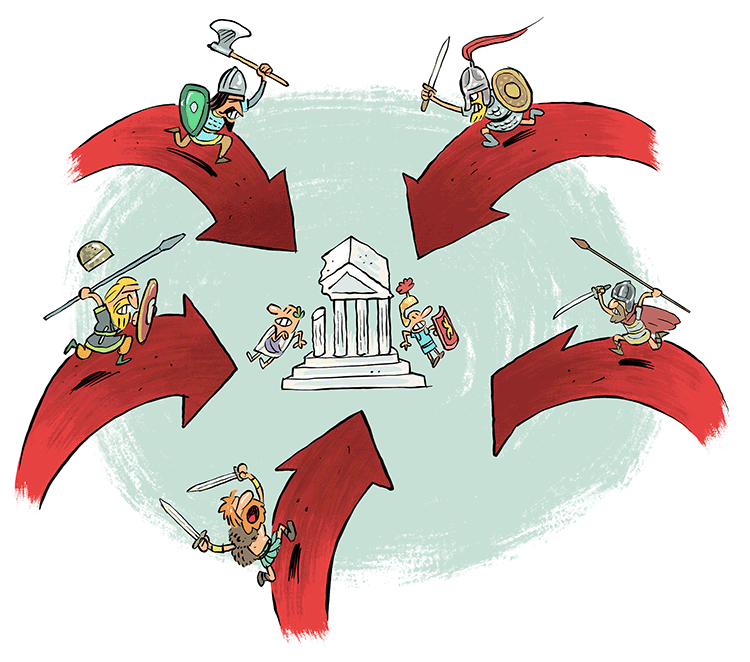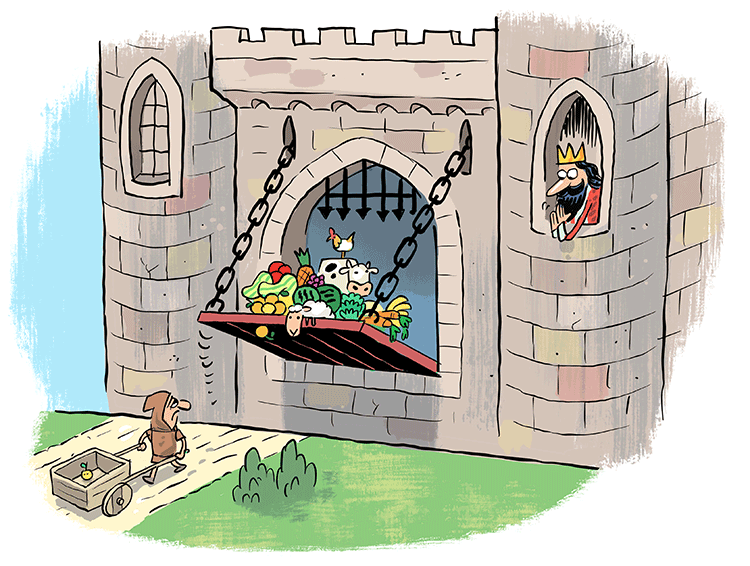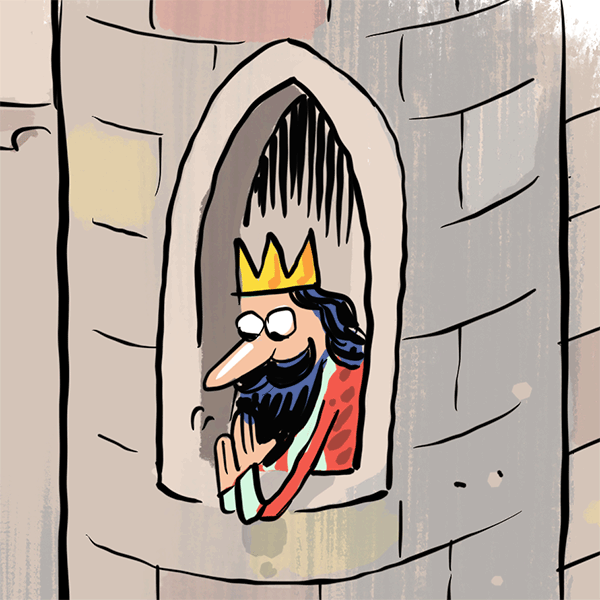The big name in European history is and always has been Rome. The “city upon a hill” rose to power as a republic during the final centuries BC, then established an empire that lasted for nearly 400 years.
But it doesn’t take a mathematician to figure out that a lot of years have passed between now and then.
So, without Rome, who’s been in control for the past 1500 or so years?
The short answer: lots of people.
Today, Europe, a continent that includes around 500 million people, is home to countless cultural and ethnic groups. Even seemingly unified nations, such as Spain, France, or Germany, are home to smaller groups that see themselves as entirely unique and independent from the country to which they belong.
Roman rule helped establish some political unity in Europe. But the keyword here is “some.” It’s difficult if not impossible to unify such a large group of different people.
So, when Rome finally did fall at the end of the 5th century BC, Europe became a bit of a free-for-all.
Different groups that had been pushed back and held back by the Romans were able to establish themselves more firmly, mostly by setting up kingdoms.
This planted the seeds for modern Europe. Not only did these early kingdoms carve out some of today’s borders (though loosely), they also allowed diversity to flourish across the continent, helping make Europe the melting pot it is today.
People and Their Groups: Europe’s Diversity
As people, we sure do love our groups. We divide ourselves up based on the languages we speak, the nations we belong to, the foods we eat, the way we look, the religions we practice, and so, so much more.
But let’s be clear, this is not a new thing.
We’ve been doing this pretty much since the moment we gained the brain power to be able to.
Something else we love to do as humans is to try and simplify things. There are so many people on this Earth, we often make big generalizations to try and make things easier.
A great example of this is Europe. Today, the continent is home to more than 500 million people across 44 different countries.
Nations are a nice way to group people together, but they’re mostly political entities, and when it comes to grouping people together, they are really just the tip of the iceberg.
Just because someone lives in Germany doesn’t mean they totally identify as German. They might be Slavic, or Bavarian, which is also the name of Germany’s southernmost state that frequently tries to break political ties with Germany. Or something completely different.
All this to say that Europe is and always has been a really diverse place. People come from all over and belong to all sorts of different groups.

Rome’s Fall Opens a Door
This diversification sped up significantly in the period following the fall of the Roman Empire.
You see, during Roman times, there was a lot of what people call “Romanization” going on. This was the process of converting local cultures into something that looked more Roman.
Such a process was made possible because Roman people, often soldiers, would make their homes in newly conquered lands. This forced the locals to learn the Roman language (Latin), follow Roman laws, and engage with Roman customs.
Even if someone had nothing to do with Rome, they were forced into being at least somewhat Roman.
The Romans also did their best to push and keep out those they deemed “Barbarians,” essentially any group that wasn’t Roman and couldn’t be Romanized. Most of these groups were Germanic, meaning they spoke a language that was the root of modern German.
Rome finally fell because these cultures, facing pressure from other groups, were forced to move south into Roman territories. And because the Roman presence was quite weak in Western Europe by this time, they couldn’t really be stopped.
Roman political power crumbled, and Romanization stopped. And the kingdoms that took Rome’s place began to spread their culture and power. This helped speed up the diversification of Europe and helped make it into the cultural melting pot it was throughout the Middle Ages and into modern times.
The Major Kingdoms of the Early Middle Ages: Setting the Stage for Modern Europe
The fall of Rome is a major moment in Western European history. Not only did it remove the strongest single political entity Europe has pretty much ever seen, but it also opened the floodgates for lots of new people to make their mark on western Europe.
The Romans called anyone living outside their territory Barbarians.
Today, this name means someone who is uncivilized. But this name is not accurate. If anything, it just speaks to Roman ignorance.
“They’re not Roman!? Ugh, what Barbarians.”
These groups were different. That’s for sure. They spoke different languages, worshiped different gods, and had different customs. They were also super into raiding and violence, which meant a lot of Romans were afraid of them.
However, they also borrowed a lot from the Romans, especially when it came to social and political institutions. So, when Rome fell and the “barbarians” moved in, it meant lots of changes for Europe. But these changes, combined with the surviving Roman influence, helped shape the Early Middle Ages and laid the groundwork for the diverse, yet connected, Europe we have today.
While there were many different groups to emerge after the fall of Rome, five specific kingdoms were particularly successful and helped facilitate the cultural transformation that took place in Europe in the centuries following the fall of the Roman Empire.
The Vandals
No, these weren’t the crazy kids in your neighborhood smashing car windows and mailboxes.
Instead, the Vandals were a Germanic tribe that originated in the lands north of the Rhine river, a major European river that starts in Switzerland and runs north through Germany and into the Netherlands.
Towards the latter period of the Roman empire, the Vandals began crossing this boundary to raid Roman cities and towns. Once the Roman Empire finally fell, they really let loose and started running wild in Roman territory, particularly in Gaul, which was basically what is now France.
But they didn’t stop there. In fact, they kept running all the way south, crossing the Mediterranean and finally settling in North Africa.
Once there, they wound up establishing a kingdom that was actually quite Roman in nature. They rebuilt many Roman buildings, including courthouses and baths, and made an effort to establish continuity with previous Roman rulers.
The arrival of the Vandals in North Africa helped promote cultural diversity in North Africa while also preserving Roman influence in the region. And the presence of such a strong kingdom on the southern coast of the Mediterranean helped keep trade between Europe and North Africa alive.
Of course, this success put a big ole target on the backs of the North Africans. The many competing powers in Europe and Asia wanted control of North Africa to control trade and make use of the region’s many resources.
So, it wasn’t long until the Byzantine Empire came marching in, and later the Arab kingdoms. But the Vandals had their moment of glory and helped lay the groundwork for the next few centuries of North African and European history.

The Ostrogoths
When we think of Italy, it’s safe to say it’s pretty Italian, no?
Well, of course! But as you will soon see, no nation, and especially no European nation, is just one thing. It’s usually a mix.
In the case of Italy, especially in the northern part of the country, there is quite a bit of Germanic influence, whether it be in the food, architecture, art, and much more. And a big reason for this was because of the Ostrogoths.
Part of a larger group known as the Goths, one of the many Germanic peoples living in Europe around the time that Rome fell, the Ostrogoths did something previously unthinkable in Roman history. They conquered Italy!
Yes, that’s right. The homeland of the Roman Empire. The boot-shaped peninsula where it all began, for a time, ceased to be controlled by Italians.
By the time the Ostrogoths arrived, Rome itself had fallen to another Germanic tribe led by a man named Odaecer. But the Ostrogoths took things a step further by taking all of Italy.
Their glory was short-lived. The Byzantine Empire came in around 100 years later to take Italy back. But once they were let in the door, the Germans were there to stay. Later on, another Germanic group, the Lombards, moved in.
They lasted a lot longer. In fact, in today’s Italy, there’s still a region known as Lombardy.
Wonder where that name came from?
All in all, the arrival of the Ostrogoths in Italy launched a transformation on the peninsula that was visible in other parts of Europe as well. Different groups came closer together, mixed, fought, shared, and helped create the cultural melting pot that Europe is today.
The Visigoths
The other major branch of Gothic people were the Visigoths.
Not unlike their cousins the Ostragoths, (they weren’t really cousins but that’s about how closely they were related), the Visigoths started moving south and west as they were being attacked by people from the east (the Huns).
History is really just a big game of cat and mouse.
But unlike their cousins, the Visigoths slammed on the brakes once they reached southern France and set up shop there for the next few centuries.
Interestingly, the Visigoths were as much Latin (Roman) as they were Germanic. Their presence on the Iberian Peninsula (the home of Spain and Portugal) helped keep Latin culture, which sort of died with the fall of Rome, alive.
This is a big reason why Spain and Portugal speak Spanish and Portuguese, two languages that derive directly from Latin.
Once again, cultural mixing was at play in Europe, and it was made possible because Rome fell and opened up space for new groups to move in.
The Anglo-Saxons
Even today, Britain is always just a little bit different than the rest of Europe.
Going back to Roman times, the island that now makes up England, Wales, and Scotland, was sort of Roman but also sort of not.
People spoke Latin, and they acknowledged Roman rule. But because it was so far away from Rome, and also because it was an island, Britain was always unique.
So, when Rome fell, it’s not a huge surprise that culture changed so much. Finally free from those pesky Romans, Germanic people began migrating onto the island in bigger numbers. Once there, they mixed and mingled with the British. These were the natives of the island. They descended from the Celts, who were a prominent cultural and ethnic group found all across Europe. And if you add in the Latin people living there, this created a totally unique culture that we now define as Anglo-Saxon.
But things weren’t all cumbaya for the people living in Britain. It took them 600 years to put together the “kingdom of England.” And even that wasn’t all-powerful.
To put it simply, the presence of so many different groups made political unity hard, but it also contributed to the region’s diversity.

The Mergovian Franks
Rounding out our list of the “Top Five Kingdoms of Europe after Rome” (unofficial ranking) are the Mergovian Franks.
One of their biggest contributions was helping us come up with the name France, which comes directly from Frank.
The Franks were, you guessed it, Germanic, though different from the other groups we’ve been discussing.
In addition to promoting cultural mixing throughout central and western Europe, the Franks also played their part in shaping modern Europe by fighting… a lot.
In a way they had no choice. Being right in the middle of Europe, lots of different groups wanted their land. But the Franks fought them back, and set up a rather strong kingdom as they did.
As they did this, though, they did something that would change Europe forever.
Holding onto all that land was hard (how did the Romans do it!?). So to keep it, Frankish leaders gave land to generals and other family members.
This spread out power in Europe and set up a new system of governance we now call feudalism.
Medieval history and feudalism pretty much go hand in hand.
So even though it was a pretty unfair and unequal system (those at the bottom of society weren’t much better than slaves), it had a pretty significant impact on the next five hundred or so years of European history.
Thanks? Franks?
But because feudalism was so decentralized (it’s tough to say any one person was really in charge), it also allowed for the presence and growth of different cultural groups, laying the foundation for today’s ever so diverse Europe.
Barbarian Kingdoms? Not So Fast
The Romans referred to the people who lived outside their imperial borders as barbarians. Over time, this word, along with others connected to these groups, such as Vandals and Goths, developed negative connotations.
But what’s in a name, really?
The truth is that these kingdoms were a pretty big deal. They borrowed a lot from the Romans but they also had their own way of doing things. And this mix, along with the absence of Roman power, launched a transformation in Europe that saw an increase in cultural diversity.
Such diversity continues until this day. And while it sometimes makes politics complicated, it also makes Europe such a unique place.
Written by Matthew Jones
Illustrated by Jean Galvao
